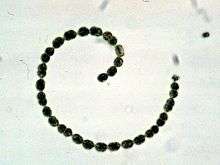Nostocales
The Nostocales are an order of cyanobacteria containing most of its species. It includes filamentous forms, both simple or branched, and both those occurring as single strands or multiple strands within a sheath. Some members show a decrease in width from the base, and some have heterocysts.
| Nostocales | |
|---|---|
 | |
| Anabaena flos-aquae | |
| Scientific classification | |
| Domain: | Bacteria |
| Phylum: | Cyanobacteria |
| Class: | Cyanophyceae |
| Order: | Nostocales T.Cavalier-Smith |
| Families[1][2] | |
| |
| Synonyms | |
| |
Environmentally, Nostocales (Sphaerospermopsis aphanizomenoides) is largely disregarded and not widely studied. However, a recent study suggests that the invasive cyanobacterium is occupying temperate lakes and thriving in them. Using principal component analysis (PCA) and the Mann-Whitney U test, results showed that total phosphorus concentration was the primary causation for the increasing abundance of S.aphanizomenoides. Nostocales is known to grow in temperate environments consisting of poor light conditions and high phytoplankton biomass, commonly found in shallow lakes. [3]
References
- Komárek J, Kaštovský J, Mareš J, Johansen JR (2014). "Taxonomic classification of cyanoprokaryotes (cyanobacterial genera) 2014, using a polyphasic approach" (PDF). Preslia. 86: 295–335.
- Nostocales on www.bacterio.cict.fr
- Budzynska, A; Rosinska, J; Pelechata, A (2019). "Environmental factors driving the occurrence of the invasive cyanobacterium Sphaerospermopsis aphanizomenoides (Nostocales) in temperate lakes". Science of the Total Environment. 650 (Pt 1): 1338–1347. Bibcode:2019ScTEn.650.1338B. doi:10.1016/j.scitotenv.2018.09.144. PMID 30308820.